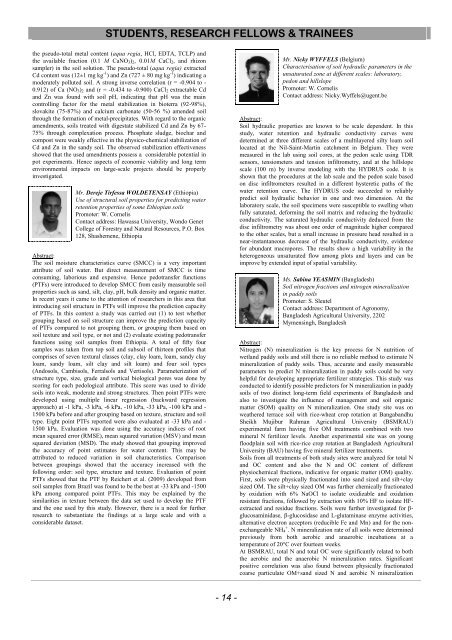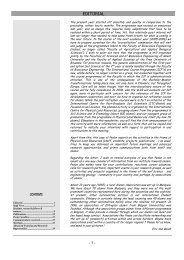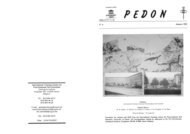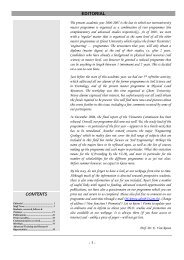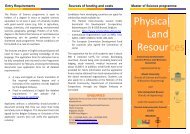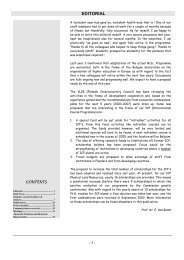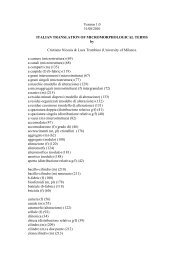Pedon 23 - Physical Land Resources - Universiteit Gent
Pedon 23 - Physical Land Resources - Universiteit Gent
Pedon 23 - Physical Land Resources - Universiteit Gent
You also want an ePaper? Increase the reach of your titles
YUMPU automatically turns print PDFs into web optimized ePapers that Google loves.
STUDENTS, RESEARCH FELLOWS & TRAINEES<br />
the pseudo-total metal content (aqua regia, HCl, EDTA, TCLP) and<br />
the available fraction (0.1 M CaNO 3) 2, 0.01M CaCl 2, and rhizon<br />
sampler) in the soil solution. The pseudo-total (aqua regia) extracted<br />
Cd content was (12±1 mg kg -1 ) and Zn (727 ± 80 mg kg -1 ) indicating a<br />
moderately polluted soil. A strong inverse correlation (r = -0.904 to -<br />
0.912) of Ca (NO 3) 2 and (r = -0.434 to -0.900) CaCl 2 extractable Cd<br />
and Zn was found with soil pH, indicating that pH was the main<br />
controlling factor for the metal stabilization in bioterra (92-98%),<br />
slovakite (75-87%) and calcium carbonate (50-56 %) amended soil<br />
through the formation of metal-precipitates. With regard to the organic<br />
amendments, soils treated with digestate stabilized Cd and Zn by 67-<br />
75% through complexation process. Phosphate sludge, biochar and<br />
compost were weakly effective in the physico-chemical stabilization of<br />
Cd and Zn in the sandy soil. The observed stabilization effectiveness<br />
showed that the used amendments possess a considerable potential in<br />
pot experiments. Hence aspects of economic viability and long term<br />
environmental impacts on large-scale projects should be properly<br />
investigated.<br />
Mr. Dereje Tirfessa WOLDETENSAY (Ethiopia)<br />
Use of structural soil properties for predicting water<br />
retention properties of some Ethiopian soils<br />
Promoter: W. Cornelis<br />
Contact address: Hawassa University, Wondo Genet<br />
College of Forestry and Natural <strong>Resources</strong>, P.O. Box<br />
128, Shashemene, Ethiopia<br />
Abstract:<br />
The soil moisture characteristics curve (SMCC) is a very important<br />
attribute of soil water. But direct measurement of SMCC is time<br />
consuming, laborious and expensive. Hence pedotransfer functions<br />
(PTFs) were introduced to develop SMCC from easily measurable soil<br />
properties such as sand, silt, clay, pH, bulk density and organic matter.<br />
In recent years it came to the attention of researchers in this area that<br />
introducing soil structure in PTFs will improve the prediction capacity<br />
of PTFs. In this context a study was carried out (1) to test whether<br />
grouping based on soil structure can improve the prediction capacity<br />
of PTFs compared to not grouping them, or grouping them based on<br />
soil texture and soil type, or not and (2) evaluate existing pedotransfer<br />
functions using soil samples from Ethiopia. A total of fifty four<br />
samples was taken from top soil and subsoil of thirteen profiles that<br />
comprises of seven textural classes (clay, clay loam, loam, sandy clay<br />
loam, sandy loam, silt clay and silt loam) and four soil types<br />
(Andosols, Cambisols, Ferralsols and Vertisols). Parameterization of<br />
structure type, size, grade and vertical biological pores was done by<br />
scoring for each pedological attribute. This score was used to divide<br />
soils into weak, moderate and strong structures. Then point PTFs were<br />
developed using multiple linear regression (backward regression<br />
approach) at -1 kPa, -3 kPa, -6 kPa, -10 kPa, -33 kPa, -100 kPa and -<br />
1500 kPa before and after grouping based on texture, structure and soil<br />
type. Eight point PTFs reported were also evaluated at -33 kPa and -<br />
1500 kPa. Evaluation was done using the accuracy indices of root<br />
mean squared error (RMSE), mean squared variation (MSV) and mean<br />
squared deviation (MSD). The study showed that grouping improved<br />
the accuracy of point estimates for water content. This may be<br />
attributed to reduced variation in soil characteristics. Comparison<br />
between groupings showed that the accuracy increased with the<br />
following order: soil type, structure and texture. Evaluation of point<br />
PTFs showed that the PTF by Reichert et al. (2009) developed from<br />
soil samples from Brazil was found to be the best at -33 kPa and -1500<br />
kPa among compared point PTFs. This may be explained by the<br />
similarities in texture between the data set used to develop the PTF<br />
and the one used by this study. However, there is a need for further<br />
research to substantiate the findings at a large scale and with a<br />
considerable dataset.<br />
Mr. Nicky WYFFELS (Belgium)<br />
Characterisation of soil hydraulic parameters in the<br />
unsaturated zone at different scales: laboratory,<br />
pedon and hillslope<br />
Promoter: W. Cornelis<br />
Contact address: Nicky.Wyffels@ugent.be<br />
Abstract:<br />
Soil hydraulic properties are known to be scale dependent. In this<br />
study, water retention and hydraulic conductivity curves were<br />
determined at three different scales of a multilayered silty loam soil<br />
located at the Nil-Saint-Martin catchment in Belgium. They were<br />
measured in the lab using soil cores, at the pedon scale using TDR<br />
sensors, tensiometers and tension infiltrometry, and at the hillslope<br />
scale (100 m) by inverse modeling with the HYDRUS code. It is<br />
shown that the procedures at the lab scale and the pedon scale based<br />
on disc infiltrometers resulted in a different hysteretic paths of the<br />
water retention curve. The HYDRUS code succeeded to reliably<br />
predict soil hydraulic behavior in one and two dimension. At the<br />
laboratory scale, the soil specimens were susceptible to swelling when<br />
fully saturated, deforming the soil matrix and reducing the hydraulic<br />
conductivity. The saturated hydraulic conductivity deduced from the<br />
disc infiltrometry was about one order of magnitude higher compared<br />
to the other scales, but a small increase in pressure head resulted in a<br />
near-instantaneous decrease of the hydraulic conductivity, evidence<br />
for abundant macropores. The results show a high variability in the<br />
heterogeneous unsaturated flow among plots and layers and can be<br />
improve by extended input of spatial variability.<br />
Ms. Sabina YEASMIN (Bangladesh)<br />
Soil nitrogen fractions and nitrogen mineralization<br />
in paddy soils<br />
Promoter: S. Sleutel<br />
Contact address: Department of Agronomy,<br />
Bangladesh Agricultural University, 2202<br />
Mymensingh, Bangladesh<br />
Abstract:<br />
Nitrogen (N) mineralization is the key process for N nutrition of<br />
wetland paddy soils and still there is no reliable method to estimate N<br />
mineralization of paddy soils. Thus, accurate and easily measurable<br />
parameters to predict N mineralization in paddy soils could be very<br />
helpful for developing appropriate fertilizer strategies. This study was<br />
conducted to identify possible predictors for N mineralization in paddy<br />
soils of two distinct long-term field experiments of Bangladesh and<br />
also to investigate the influence of management and soil organic<br />
matter (SOM) quality on N mineralization. One study site was on<br />
weathered terrace soil with rice-wheat crop rotation at Bangabandhu<br />
Sheikh Mujibur Rahman Agricultural University (BSMRAU)<br />
experimental farm having five OM treatments combined with two<br />
mineral N fertilizer levels. Another experimental site was on young<br />
floodplain soil with rice-rice crop rotation at Bangladesh Agricultural<br />
University (BAU) having five mineral fertilizer treatments.<br />
Soils from all treatments of both study sites were analyzed for total N<br />
and OC content and also the N and OC content of different<br />
physiochemical fractions, indicative for organic matter (OM) quality.<br />
First, soils were physically fractionated into sand sized and silt+clay<br />
sized OM. The silt+clay sized OM was further chemically fractionated<br />
by oxidation with 6% NaOCl to isolate oxidizable and oxidation<br />
resistant fractions, followed by extraction with 10% HF to isolate HFextracted<br />
and residue fractions. Soils were further investigated for β-<br />
glucosaminidase, β-glucosidase and L-glutaminase enzyme activities,<br />
alternative electron acceptors (reducible Fe and Mn) and for the nonexchangeable<br />
NH 4 + . N mineralization rate of all soils were determined<br />
previously from both aerobic and anaerobic incubations at a<br />
temperature of 20°C over fourteen weeks.<br />
At BSMRAU, total N and total OC were significantly related to both<br />
the aerobic and the anaerobic N mineralization rates. Significant<br />
positive correlation was also found between physically fractionated<br />
coarse particulate OM+sand sized N and aerobic N mineralization<br />
- 14 -


